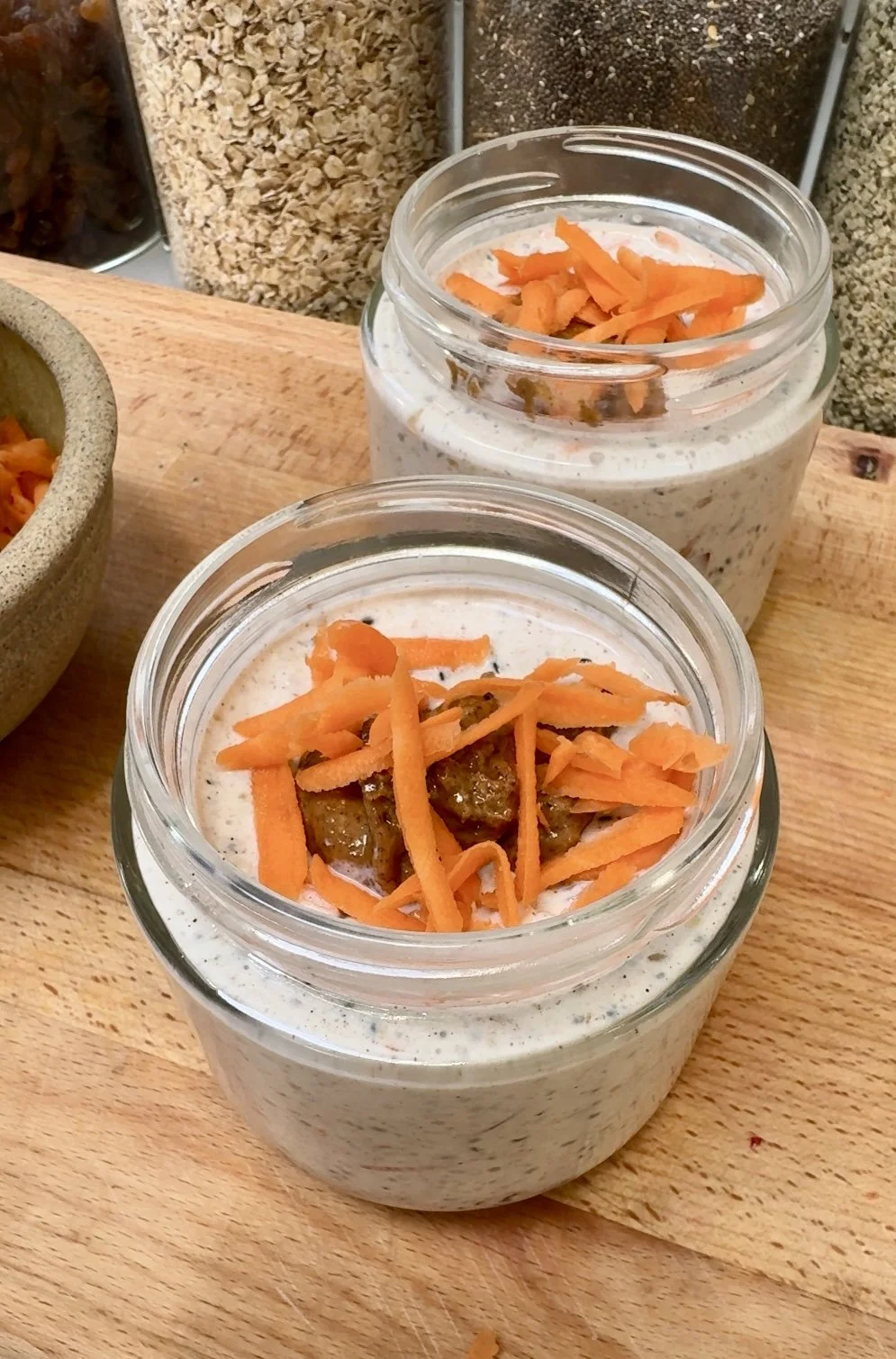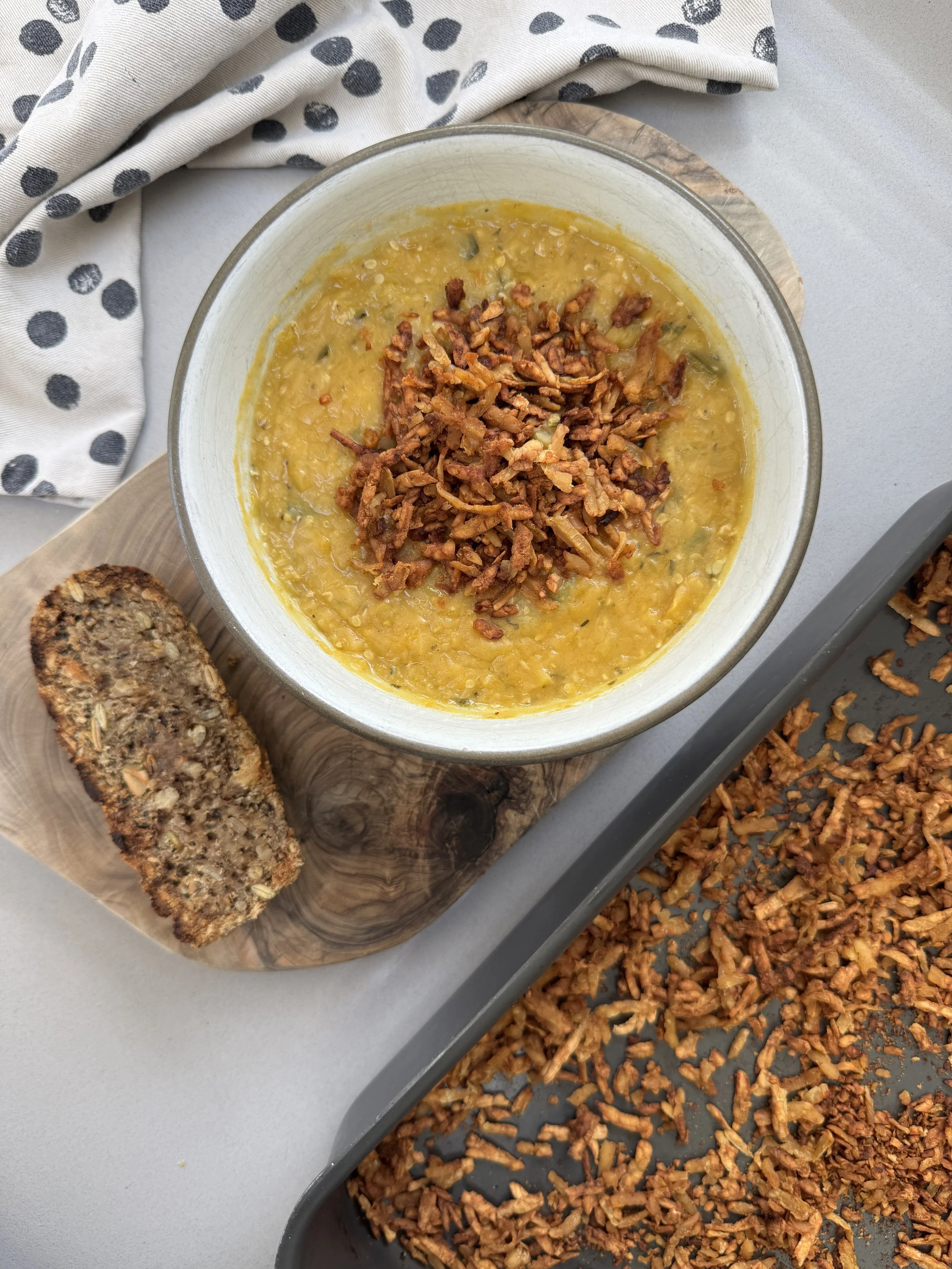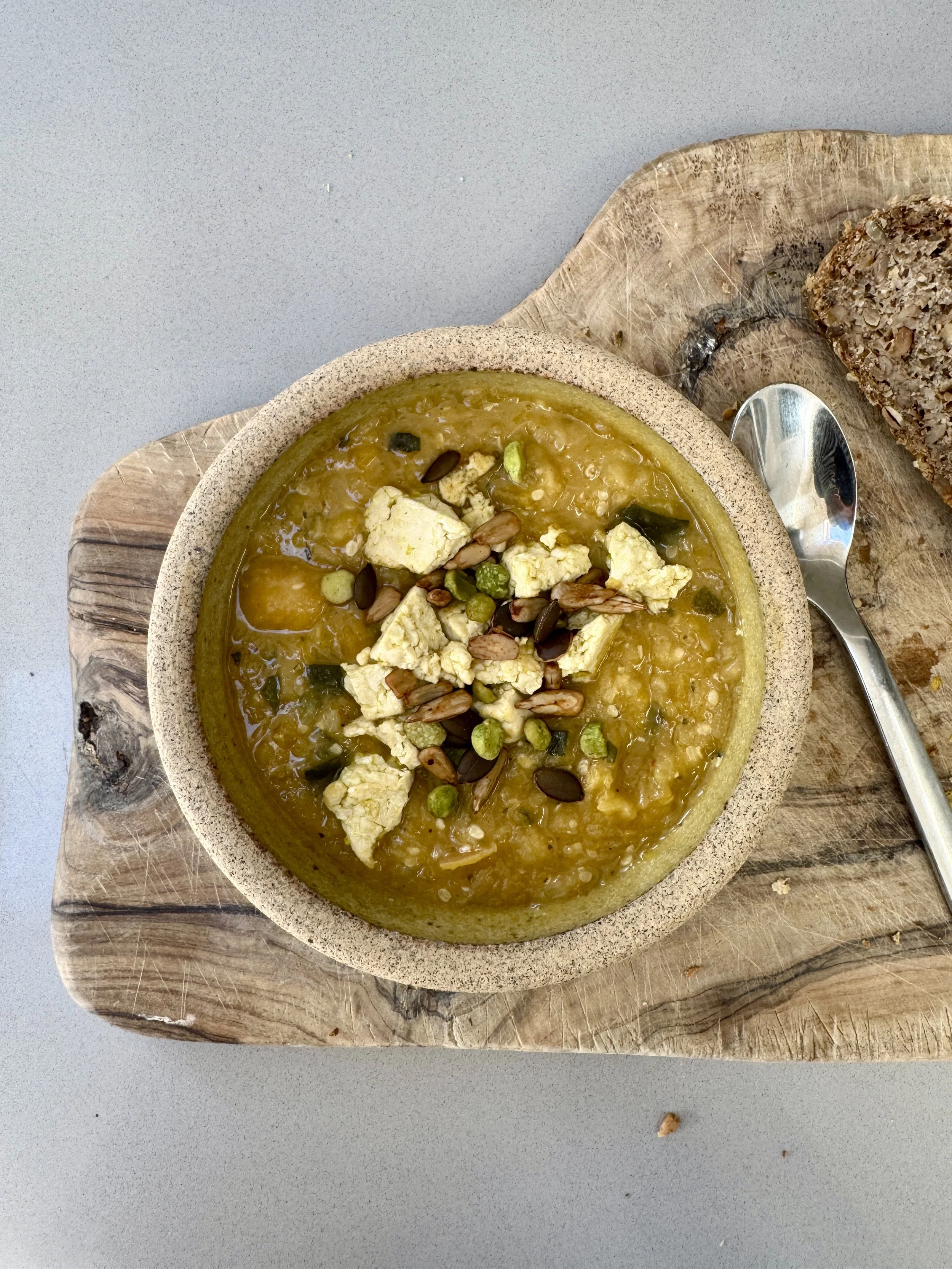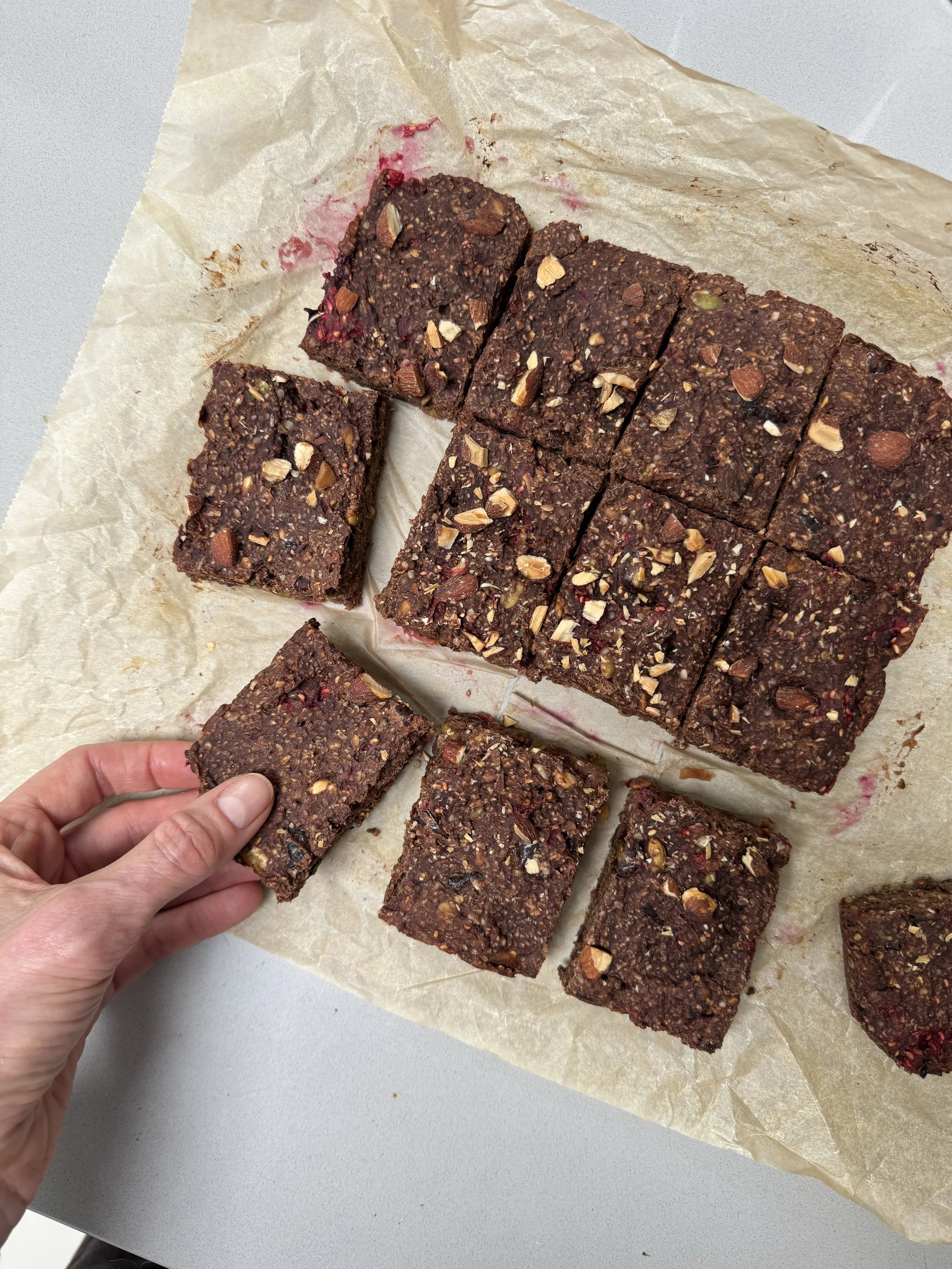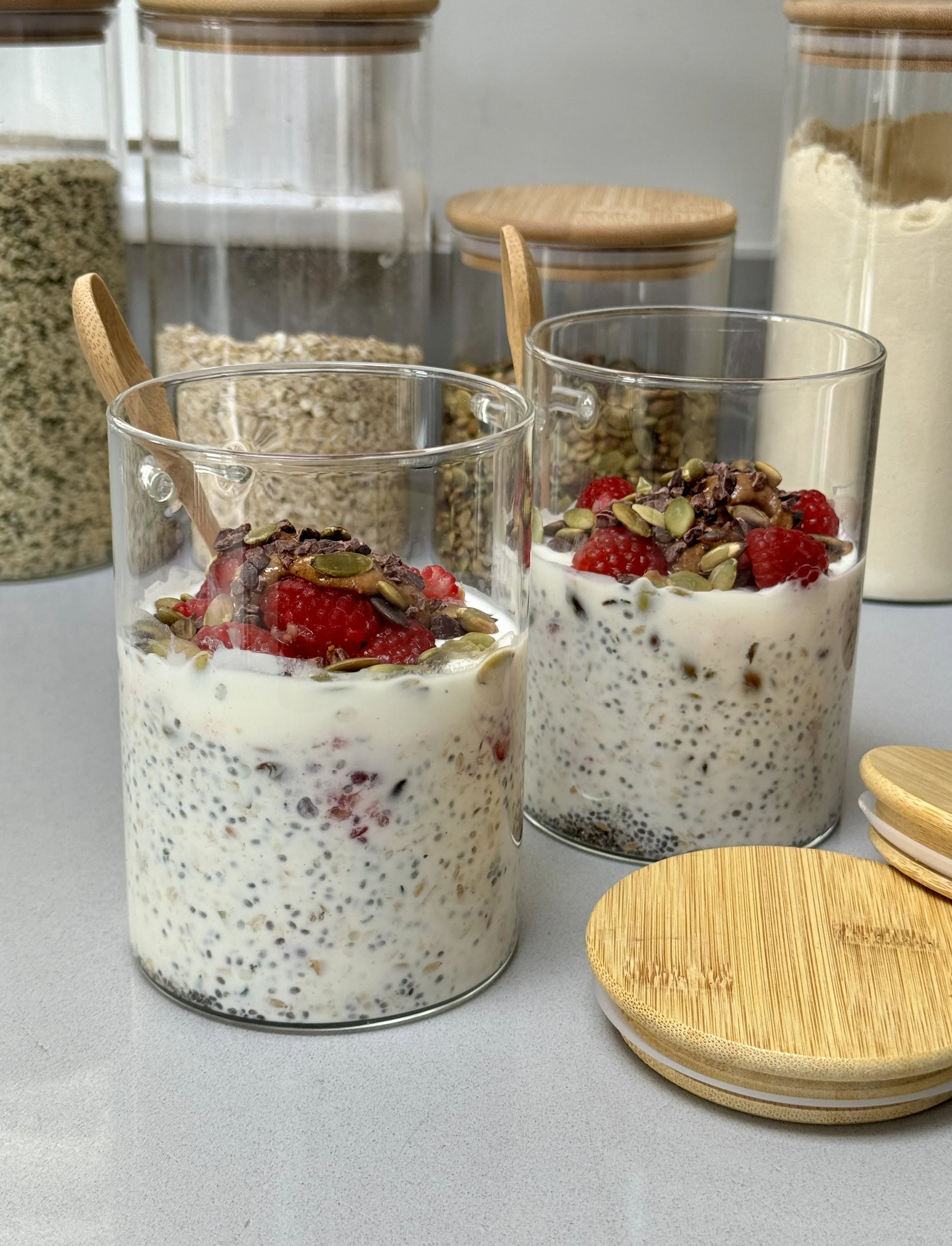Carrot cake breakfast pots
Why a high-protein, high-fibre breakfast matters
Starting the day with a balanced meal that’s rich in protein and fibre helps to set up your metabolism, appetite, and energy levels for the rest of the day. Protein slows digestion and supports the release of satiety hormones such as GLP-1 and PYY, helping you feel fuller for longer and less likely to reach for snacks mid-morning. Fibre further stabilises this effect by slowing glucose absorption and supporting a steady blood-sugar response, which means fewer energy dips and cravings later on. Together, they promote sustained concentration and energy, while providing key nutrients for muscle repair, gut health, and hormone production.
For women in midlife, this combination becomes particularly important. As oestrogen levels fluctuate and eventually decline, the body’s ability to maintain muscle mass, insulin sensitivity, and appetite regulation naturally decreases. A protein-rich breakfast helps counter these shifts by supporting lean tissue and metabolic health, while fibre nourishes the gut microbiome, which in turn influences inflammation, oestrogen metabolism, and mood. In short, a high-protein, high-fibre breakfast is one of the simplest ways to steady hormones, support energy, and keep you feeling balanced through the day.
Ingredients
Protein: ~27 g Fibre: ~11 g
Ingredients
Serves 1
1 tbsp rolled oats
½ tbsp chia seeds
½ tbsp ground flaxseed
2 tbsp shelled hemp seeds
1 tbsp pumpkin seeds
100 g high-protein Greek yoghurt
6 tbsp unsweetened nut, coconut or cow’s milk (e.g. Plenish)
30 g apple, finely chopped
30 g carrot, grated
1 tbsp sultanas
Topping
½ tbsp almond butter
1 tsp cacao nibs, chopped nuts or desiccated coconut
Method
In a bowl or jar, combine the oats, chia, flax, hemp, and pumpkin seeds.
Add the Greek yoghurt and milk, alternating small amounts of each while stirring until you have a thick, even mixture.
Fold through the apple, carrot, and sultanas.
Cover and refrigerate overnight (or for at least 2 hours) to allow the chia and oats to soften.
Add the toppings or leave until you are ready to eat.
Crunchy carrot & kohlrabi salad
Simple and very effective! I love this salad.
It’s the perfect side dish: crunchy, fresh, and tastier than the sum of its parts - plus it goes with everything! It’s delicious with grilled chicken, fish, halloumi, or spicy tofu. I’ve just topped with spring onion, but you can also add raisins, grated apple, pumpkin or sunflower seeds, toasted nuts, or crumbled feta.
If you can’t get hold of kohlrabi, sub with finely chopped cabbage, broccoli, or radishes - or any combination. The more, the merrier where raw veggies are concerned in this salad.
But let’s get into the nutrition for a minute before the instructions:
Carrots are an excellent source of beta-carotene, a type of vitamin A that gives them their vibrant orange colour, and is crucial for vision, immune function, and skin health. Carrots also contain vitamin K1, essential for blood clotting; vitamin B6, which supports a healthy metabolism; and manganese, which is important for bone health and metabolism.
Beta-carotene, along with alpha-carotene and lutein in carrots, are antioxidants; these compounds help protect cells from free radicals. Free radicals are unstable molecules that can damage cells and are associated with inflammation, and an increased risk of developing heart disease, and certain cancers.
Like kohlrabi, carrots are a good source of dietary fibre, which aids digestion, promotes feelings of fullness, and may help regulate blood sugar levels and lower cholesterol. Both veggies are good sources of potassium, which helps regulate blood pressure and supports heart health and muscle function.
Kohlrabi belongs to the cabbage family and is high in vitamin C, an important antioxidant that supports the immune system, promotes skin health, and aids in wound healing. One cup of raw kohlrabi contains over 90% of an adult's recommended daily vitamin C intake!
Kohlrabi also contains vitamin B6, which plays a key role in metabolism and brain function, and folate, which is important for cell division and the production of DNA.
And now, how to make this delicious salad….
ingredients
Serves 2 generous portions or 4 as a side dish
2 carrots, unpeeled but washed
1 kohlrabi
2 tbsp extra virgin olive oil
1 tbsp apple cider vinegar (or wine vinegar)
1 tsp wholegrain mustard
Good pinch of sea salt
1 spring onion, sliced finely
method
Chop the ends of the carrots and grate.
Chop the ends and leaves off the kohlrabi, peel them, and then grate them. I just peeled the rough bits and left the rest of the skin on.
Mix the dressing: olive oil, vinegar, mustard and salt.
Mix the vegetables on a serving plate, plus raisins if you’re using them.
Pour over the dressing and combine well.
Top with spring onion and any nuts, seeds, or cheese that you’re using - walnuts would be great with apples and raisins.
Carrot, squash & lentil soup
This is a gorgeous warming soup with lots of fresh ginger and roasted garlic to support your immune system, detoxification, and blood sugar regulation.
Red lentils are full of fibre to keep your gut microbes happy, plus they’re a great source of vitamins B9 or folate (tissue and cell growth and function), copper (red blood cells, nervous system support), manganese (immune system regulation and bone formation), and iron (red blood cells, oxygen transport, energy) amongst others. You’re getting some more fibre from the squash and carrots (happy gut bugs!) plus antioxidants (cell damage/cancer-prevention), vitamin C, beta-carotene (converts to Vit A for eye health), and B6 (supports mood), so there’s all the good stuff in this recipe! Perfect for this time of year.
Ingredients
Serves 6
· 4 large garlic cloves (unpeeled)
· 1 large onion, chopped in thick half-moons
· 1 medium butternut squash (approx. 600-700g), 2cm dice
· 3 large carrots (300g), 2cm dice
· 1 thumb ginger, peeled and grated (I use a microplane)
· 1.5L chicken or veggie stock, warmed
· 100g red lentils, rinsed well
· 1 tsp sea salt
· Lots of black pepper
Method
· Heat the oven to 180 c, add the veggies to a large roasting tray, drizzle with olive oil and mix with a pinch of salt.
· Put in the oven for 20 minutes, then turn and put back in for approx. another 20 minutes until completely softened.
· Take the veggies out and remove the garlic, chop the root ends off and squeeze out the cooked cloves into a large stock pot, then scrape in the onions, squash and carrots.
· Deglaze the roasting tray with a ladle or two of stock and add to the pan along with the ginger and the rest of the stock.
· Bring to the boil and then blitz with a hand blender until smooth.
· Add the lentils and simmer with the lid on for another 25 minutes.
· Finish by adding the salt and lots of pepper for extra heat.
Roasted carrot & quinoa salad with wilted spinach & dukkah
Ingredients
Serves 6-8
180g quinoa, cooked as per the packet instructions - usually rinse well until the water runs clear and then simmer for 20 minutes
5 carrots or approx 300g, chopped in thick batons
2 red onions, sliced in half moons
6 tbsp olive oil
1 tbsp white wine vinegar or lemon juice
2 1/2 tbsp dukkah spice mix (recipe linked here)
2 handfuls of spinach
Handful of parsley or coriander to serve, optional
200g crumbled feta, optional
Method
Preheat the oven to 180°c.
Cook the quinoa and add 1 tbsp of dukkah spice mix to the water, then drain and put back in the pan with the lid on to keep warm.
Put the carrots and onions on a large tray, or split between two so you have space between all the veggies to allow them to roast and brown rather than steam. Drizzle with 2 tbsp olive oil and sprinkle over 1 tbsp of dukkah, then mix to coat well. Place in the oven.
After 15 minutes check the veggies and turn to brown on the other side. Cook for a further 8-10 minutes.
Meanwhile get a large serving dish and spread out the spinach.
Mix the remaining 4 tbsp olive oil and lemon juice (or vinegar) into the drained quinoa and then spoon about 1/3 on to the serving dish covering the spinach. Add a scattering of carrots and onions, then repeat until you’ve used everything up.
You can sprinkle in the herbs while you’re layering or just add a handful on top to finish with the last 1/2 tbsp of dukkah.
I also love to top this salad with feta as it’s creamy saltiness goes so well and makes it a complete lunch. If you’re vegan you could add some toasted sunflower or pumpkin seeds for extra protein instead.
Filter by Tag
- aubergine
- Dark chocolate
- beans
- breakfast
- Middle Eastern
- Moroccan
- almond
- blueberry
- BBQ
- Mexican
- Spice blend
- basil
- asparagus
- blueberries
- Prawns
- Thai
- Blog
- Breakfast
- Topping
- Winter
- bone broth
- Nutrition
- black beans
- Christmas
- French
- Spanish
- banana
- apricot
- Italian
- avocado
- almonds
- banana bread
- biscuits
- adzuki beans
- Indian
- bologese
- beetroot
- Asian
- Sweet potato
- Yorkshire
- Yorkshire puddings
- Ottolenghi
- bread
- Honey & Co
- asian
- Nigella Lawson
- bake
- Meera Sodha
- Lepard
- baking

